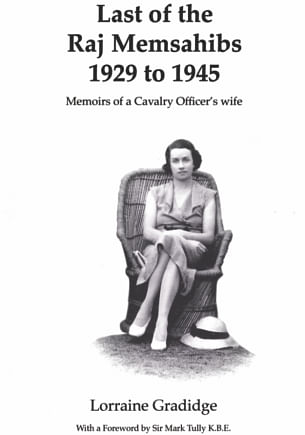Last of the Raj Memsahibs
Last of the Raj Memsahibs
By Lorraine Gradidge, 2013, Podkin Press, Kent, UK

‘As I write this in Lymington in 1978, the widow of an Indian Cavalry Officer, I am a member of a dying breed' begins the Preface to this book. The author wanted to correct the derogatory impression of the English memsahib in India as a mindless female, whose sole interests were drinking cocktails, dancing and 'ordering servants about like slaves'. The passage of time since these memoirs were written has somewhat altered our view of the upper-class English woman in the dying days of the British Raj. There have been further sturdy defences of such women and many similar autobiographical accounts. In the late 1970s the 'raj industry ' was just beginning to get underway and it has subsequently resulted in a number of sociological studies examining colonial attitudes and networks. 'Memsahibs' were frequently sought through BACSA and other channels for interviews by keen young researchers for many years. The reason is clear. As Sir Mark Tully writes in his Foreword to this book: 'It seems incredible that such a life still existed right up to the Second War.” It does indeed. There are the hunting parties, parties with Maharajahs, the hierarchy of servants, forty-hour train journeys (first class, of course), and much else that is over-familiar today.
But what this book does reveal, and what makes it worth reading today, is how British India was entirely a man's world. 'Women did not seem to belong to it…our lives were lonely and at times dull, whereas our husbands' lives were completely fulfilled with their horses, mess, polo and constant alert for the possibility of active service.' On the North West frontier, where the Gradidges were stationed for some time, Indian women were simply invisible, so there was no possibility of making friends there. Frequent moves did not help either, making it difficult to build up a social circle, although it is clear there was warm hospitality among the British towards people of their own kind.
The author lived in India as a small child because her father was a Calcutta lawyer, and her childhood memories, which open this book, are vivid. After schooling in England, she returned in 1929, aged nineteen, already married, and with a six week old baby. Two more children were born, the last in traumatic circumstances. It seems extraordinary that the children were sent back to England by sea in wartime, risking enemy bombing, in order to get a 'proper education'. Joining the Womens' Voluntary Service (WVS) led to war work in Dehra Dun and Chittagong, before the author finally left India in 1945, to be followed by her husband a year later. This book is very much of its time, and should be read as such, without trying to put a twenty-first century gloss to it.
The reviewer, Dr Rosie Llewellyn-Jones, MBE, is an eminent British historian specializing in Nawabi Lucknow. This review first appeared in the Chowkidar in 2013, a journal of BACSA, UK. Rosie's latest book: The Last King In India Wajid Ali Shah, was published in 2014, to wide acclaim.
Courtesy: Waqar A Khan